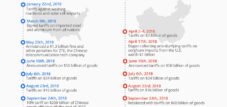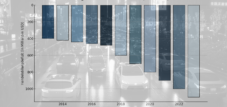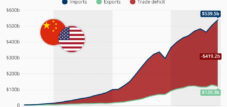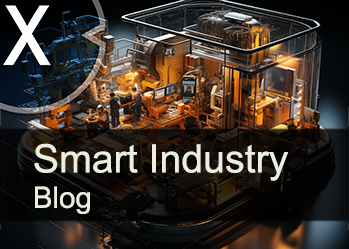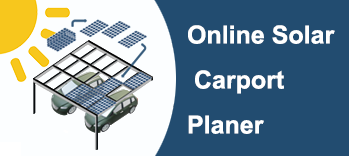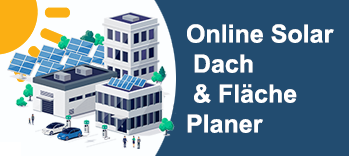Escalation in the US-China trade conflict: 100 percent tariffs, export controls on software, and the shaky Trump-Xi meeting in South Korea
Language selection 📢
Published on: October 11, 2025 / Updated on: October 11, 2025 – Author: Konrad Wolfenstein

Escalation in the US-China trade conflict: 100 percent tariffs, export controls for software, and the shaky Trump-Xi meeting in South Korea – Image: Xpert.Digital
Tariffs, raw materials, summit poker: The conflict between the US and China is escalating – the most important facts
100% tariffs & software blockade: The trade war with China enters a new, dangerous phase
The US government announces additional 100 percent tariffs on all imports from China and envisages export controls on "critical" software. This move comes in response to Beijing's tightened export controls on rare earths. At the same time, the US president is questioning a planned meeting with Xi Jinping at the APEC summit in South Korea, but is leaving a loophole open. The decision increases the risks for global supply chains, technology flows, and industrial prices—especially in industries dependent on rare earths, from semiconductors to automotive and defense.
Suitable for:
- Global CEO Report: Not only Germany’s top managers are worried about the future – Three macro trends dominate perceptions
What exactly did the US government announce?
The announcement includes two core elements: first, additional tariffs of 100 percent on all imports from China, to take effect no later than November 1; second, new export controls on "all important" or "critical" software, which could take effect on the same date. Statements left open whether the 100 percent tariffs would apply in addition to existing tariffs or replace them entirely. The President linked this with the justification that China is acting "extraordinarily aggressively" and tightening export controls in the strategic area of rare earths and related technologies.
What triggered this escalation?
The reason for this is a significant tightening of Chinese export controls on rare earths and related technologies. Beijing is imposing licensing requirements for the export of machinery, technologies, and processes for mining, processing, as well as assembly, maintenance, and upgrading of related production lines. There are also reports that China is expanding controls, so that transactions involving rare earths or products with Chinese components could be treated restrictively. Beijing cites national security as the motive, as rare earths also have military uses.
Why are “rare earths” so central to the debate?
Rare earths are essential for high-tech products, the energy, and defense industries: from permanent magnets in electric motors and wind turbines to semiconductor processes, sensors, smartphones, and defense systems. China has a virtual monopoly along the supply chain: approximately 60–70 percent of mining and around 90 percent of processing take place there. This dominance makes Beijing's export policy a powerful lever on global supply chains and prices.
Suitable for:
- Rare earths: China's raw material dominance-with recycling, research and new mines out of raw material dependency?
Did the US government cancel the meeting with Xi Jinping?
The meeting at the APEC summit in South Korea was briefly called into question; the US president stated that there appeared to be "no reason" for it. Shortly afterwards, however, he clarified that the meeting had not been canceled; he would be there and assumed it could take place. This communication signals a buildup of pressure while simultaneously maintaining tactical openness for de-escalation or negotiation.
Where and when should the meeting take place?
The APEC Leaders' Meeting will take place in South Korea from the end of October to November 1, 2025. The central Leaders' session and the CEO Summit are scheduled for Gyeongju; accompanying ministerial meetings and forums will be held in Incheon, Busan, Jeju, and Seoul, among other cities. The CEO Summit is scheduled for October 28–31; Leaders' Week culminates in Gyeongju on October 31 and November 1.
What is the context of the customs announcement regarding the recent “customs pause”?
In the spring, both sides sharply increased tariffs, then paused them temporarily in the summer or negotiated in rounds. Now the conflict is escalating again. It remains unclear whether the 100 percent tariffs will apply in addition to previously imposed surcharges. This lack of clarity in communication increases uncertainty, also because export controls for software were announced in parallel, the specific scope of which is unclear.
What is meant by “export controls for critical software”?
The government is announcing export restrictions for "important" or "critical" software. Open questions concern the precise scope of application. This could include software for chip development (EDA), firmware/OS components, industrial control software, or safety-critical tools along strategic supply chains. The technology sector is assessing this in the context of the ongoing US approach to limiting strategic technology transfers to China. Stricter licensing requirements for EDA and related tools were previously proposed to prevent circumvention via subsidiaries.
How did the financial markets react?
The announcements put pressure on major stock indices in the US and Europe; risk assets declined, while safe-haven assets (e.g., gold prices) rose. Observers spoke of a return of trade war fears and a more defensive risk positioning in the markets immediately following the statements.
Suitable for:
What immediate economic effects can be expected?
Higher import prices in the US are to be expected in the short term, especially if the 100 percent tariffs are also applied. This affects both final and intermediate products, complicates cost structures for US industry and trade, and can have a stimulating inflationary effect. Model-based simulations indicate significant price impulses and strains on exports in the US under extensive tariff regimes, while China experiences relatively smaller effects, but global growth and trade suffer. European effects are heterogeneous: on the one hand, relief from diverted goods flows with possible price declines for imports; on the other hand, competitive pressure from Chinese overcapacities and strains in China-exposed industries.
Are European supply chains directly threatened?
Yes, especially where rare earths are used in components and intermediate products. The European automotive, mechanical engineering, electronics, and defense industries are severely affected, as magnets, motors, and sensors often use rare earths. Industry associations are warning of supply bottlenecks and production cuts. Suppliers have been reporting initial downtimes and declining planning reliability since spring. Tightened Chinese export controls increase the risk of further delays and price surges.
How strong is Western dependence on China's rare earth chain?
It is significant: around 60–70 percent of production, and about 90 percent of smelting/processing takes place in China; Germany imports a significant share from China. In addition, China possesses patents and process know-how that make it difficult to quickly develop alternative capacities. The EU classifies rare earths as critical raw materials and is working on diversification, recycling, and domestic capacities – albeit with long lead times and environmental regulations.
What role does the APEC summit in Gyeongju play?
The APEC Summit serves as a platform for economic policy coordination in the Asia-Pacific region. Gyeongju will host Leaders' Meetings and the CEO Summit in 2025. Before the recent tensions, a bilateral Trump-Xi meeting and a framework for further talks (including on technology, trade, and TikTok) were promised. The escalation complicates agreements but also leaves open the option of a last-minute political deal, as both sides had signaled a willingness to negotiate.
What distinguishes the current escalation from previous rounds?
What's new is the severity of Chinese export controls on the area of rare earth processing technology. This goes beyond mere raw material exports and has extraterritorial effects when components with Chinese content are involved. On the US side, the combination of blanket 100 percent tariffs and generic (still undefined) software export controls sends a strong signal, going beyond product- or sector-specific measures and deliberately using uncertainty as leverage.
How realistic is a quick de-escalation?
Politically, de-escalation is possible through tactical communication, especially around the summit date. The US President left room to make tariffs dependent on China's reactions; conversely, Beijing can modulate export control practices. However, both sides have taken measures that can be institutionally anchored (licensing requirements, sanctions lists, export controls), which reinforces the structural decoupling trend. A short-term symbolic easing of tensions appears possible, but a sustainable, structural de-escalation less likely.
Which sectors are most exposed?
Particularly exposed are:
- Semiconductors and electronics, including EDA software and manufacturing chemicals, as both US export controls and Chinese materials are affected.
- Automotive industry, especially e-mobility and suppliers, due to their dependence on magnets and sensors containing rare earth elements.
- Renewable energies/infrastructure, especially wind turbines (permanent magnet generators) and power electronics.
- Defense and aerospace due to special alloys, sensors, drives and electronics.
Is there already evidence of supply problems in Europe?
Since April, reports and industry association announcements have indicated the first supplier shutdowns and a throttling of production lines in Germany due to difficulties in procuring rare earths and magnet products. Companies indicate that approval processes, licensing, and logistics delays are lengthening lead times and reducing inventories faster than planned.
Are there new price surges for rare earths looming?
Yes. News of tightened export controls already led to noticeable price increases this summer. A further round of restrictive measures or counter-tariffs increases the risk of another price surge, especially for heavy rare earths (e.g., dysprosium, terbium), which are needed for high-temperature magnets and where Chinese dominance is particularly strong.
Could China interpret export controls extraterritorially?
Evidence suggests that Beijing could also apply restrictions to products from foreign locations that contain components or materials with Chinese rare earth content. Enforcement and review mechanisms are unclear, but the signaling effect increases compliance risks for globally operating companies that have a presence in China or remain intertwined with Chinese chains.
Our global industry and economic expertise in business development, sales and marketing

Our global industry and business expertise in business development, sales and marketing - Image: Xpert.Digital
Industry focus: B2B, digitalization (from AI to XR), mechanical engineering, logistics, renewable energies and industry
More about it here:
A topic hub with insights and expertise:
- Knowledge platform on the global and regional economy, innovation and industry-specific trends
- Collection of analyses, impulses and background information from our focus areas
- A place for expertise and information on current developments in business and technology
- Topic hub for companies that want to learn about markets, digitalization and industry innovations
Price shock or opportunity? Consumers and industry in a tariff dilemma
What possible countermeasures is the US considering beyond tariffs?
In addition to tariffs, expansion and tightening of export controls are under consideration, particularly for semiconductors, manufacturing equipment, and associated software (EDA, firmware). In addition, investment and procurement priorities can be adjusted in favor of domestic buyers to mitigate bottlenecks in critical sectors. Prioritizing American demand for advanced AI chips has already been debated. The options range from sectoral rules to broad lists of critical software.
Suitable for:
Can Europe benefit – or will it be burdened?
Both are possible. Potentially lower import prices for certain consumer goods through the redirection of Chinese exports, as well as increased access to intermediate products if US demand is dampened by tariffs, have a positive impact. Negative factors include competitive pressure from Chinese overcapacity in Europe (e.g., steel, consumer goods), the burden on industries exposed to China, and vulnerability to rare earth shortages. The bottom line is that key sectors face a net burden, while consumers in selected segments could benefit from price competition.
What role do political narratives and timing play?
Linking the tariffs to the summit timing and the dramatic rhetoric (hostage-taking, hostile practices) serves as a negotiating tactic. On the Chinese side, references to national security and military use underscore the legitimacy of export controls. Both narratives provide domestic political justifications and increase external pressure without blocking options for a "face-saving" arrangement.
What paths of de-escalation are conceivable?
- Temporal extension or differentiated application of 100 percent tariffs (exemptions, lists, transitional periods).
- Clarification and limitation of the software concept to defined, safety-relevant categories (e.g. EDA) instead of blanket formulations.
- Chinese licensing practices, which remain formally strict but alleviate operational bottlenecks through more generous approvals.
- Technical working groups within the APEC framework that harmonize export control standards and compliance issues to reduce extraterritorial frictions.
What is the probability of a “hard” decoupling?
For years, the trend has been toward structural decoupling in sensitive technologies. A hard, broad decoupling is economically expensive and politically risky, but remains likely in defined segments (AI chips, EDA, lithography, rare earth technologies). Recent steps by both sides cement instruments that can be politically modulated in the short term but continue to be used in the long term.
What lessons can be learned for industrial companies?
- Diversification of sources for rare earth magnets and oxides; evaluation of alternative alloys and magnet-free designs where technically feasible.
- Stockpiling and long-term call-off contracts for critical components; closer integration of engineering and purchasing for substitution.
- Tighten export compliance: risk screening for software, firmware, and development tools; legal assessment of extraterritorial rules.
- Scenario planning along the lines of "customs and export controls" versus "license relaxations"; price adjustment clauses and dual supply chain models.
What does this situation mean for consumer prices in the US?
In the event of additional tariffs across the board, consumer prices tend to rise, especially for goods with a high Chinese content. Model analyses show that low-priced intermediate and final products will be scarce, creating inflationary pressure. At the same time, some exports could be offered domestically, depressing export figures. Overall, this will put a strain on purchasing power and exports in the short term.
How is China reacting to the US tariffs?
Immediately following the US announcements, there was no detailed official Chinese response to the tariffs. Political and media signals focused on its own export control agenda, which was justified as a legitimate security measure. Observers also view Beijing's actions as a deliberate bargaining chip ahead of the summit.
Is the escalation linked to geopolitical tensions beyond trade?
Yes. Tech competition (AI, semiconductors, telecom), security issues, and alliances in the Asia-Pacific region are closely intertwined. Export controls and tariffs act as levers in a larger strategic rivalry. APEC provides a multilateral framework, but cannot resolve fundamental strategic differences in the short term.
What signaling effect does the 100 percent tariff figure have?
The round, high number is symbolically maximum and generates pressure and attention. However, its effect depends on the precise implementation: scope of application, exceptions, transitional rules, and administrative enforcement. The more diffuse the announcement, the greater the uncertainty in supply chains and markets—part of the intended leverage.
What could exceptions or licenses look like?
On the US side, carve-outs for medical goods, safety-relevant components, or consumer price-sensitive categories are conceivable, provided they are politically opportune. In the case of software export controls, licensing paths could be established for non-security-relevant tools. On the Chinese side, licenses could be granted to selected customers/projects that are politically uncritical or that promise counter-business.
What role do third countries and circumvention routes play?
During previous rounds, production chains were relocated to ASEAN countries. An expansion of US tariffs on products originating from third countries or a tightening of "rules of origin" can curb such circumvention. China, for its part, is addressing circumvention by extending controls to technology transfers and cooperation with international partners. This increases the complexity for companies with network manufacturing.
Can Europe reduce its dependence on rare earths in the short term?
Hardly in the short term. Medium-term options include rebuilding domestic processing, recycling, diversification (e.g., Australia, the USA, Africa), material substitution, and design changes. High environmental and permitting standards extend the time horizons but reduce external costs. Political initiatives at the EU level are intended to promote raw material security and processing capacity, but scaling up will take years.
Which lines of communication are visible from the US side?
- Tough action against “hostile” trade practices; protection against “hostage-taking” by China’s raw material dominance.
- Announcement of maximum tariffs and parallel tech controls, coupled with the option of making the timing or scope dependent on China's behavior.
- Open door for meetings and negotiations to signal flexibility and maintain pressure as a negotiating tool.
How does this fit into the history of the US-China trade conflict?
Since 2018, the conflict has escalated in waves: tariff increases, countermeasures, temporary pauses, and partial solutions ("Phase One"), flanked by export controls and tech sanctions. The current cycle shifts the focus more toward access to raw materials and technology, operating with extraterritorial effects on both sides. The fundamental points of contention (trade balance, IP protection, technology transfer, security) remain unresolved.
Which next milestones are relevant?
- Specific US regulations on the 100 percent tariffs: scope, exceptions, and timeline.
- Clarification of “critical software” and licensing procedures.
- Chinese implementation guidance on export controls: licensing practices, review criteria, extraterritorial application.
- Political communication before and during the APEC Summit; status of the bilateral meeting and possible "mini-deals."
What should corporate decision-makers do now?
- Instant inventory and exposure analysis for rare earth materials, magnets, and critical software dependencies.
- Qualify alternative suppliers; review and prioritize safety stocks.
- Update contractual clauses on force majeure, export controls, and customs changes.
- Strengthen compliance teams and legal counsel for export control and customs issues; increase traceability.
- Keep communication lines with customers transparent, anticipate price adjustments and delivery times.
Suitable for:
What is the most likely development in the next few weeks?
A period of high rhetoric with parallel technical discussions is likely. Regulatory texts will provide clarity on the scope and exemptions. Short-term market volatility and precautionary measures in affected industries are likely. Whether a symbolic signal of easing tensions will emerge around APEC depends on the scope for maneuvering on both sides. Structurally, everything points to continued risk premiums in sectors with rare earth and tech dependence – and to continued pressure to diversify supply chains.
Which information points do BILD and SPIEGEL confirm in this context?
Both consistently report on the announcement of additional 100 percent tariffs, the planned software export controls, the justification based on Chinese export controls on rare earths, and the meeting with Xi at the APEC summit in South Korea, which was initially questioned but later reopened, was held up. Both note that an official, detailed Chinese response was initially pending.
What open questions remain unresolved from today’s perspective?
- Will the 100 percent tariffs be added to existing tariff rates or will they replace them?
- How narrowly or broadly is “critical software” defined, and what licensing processes apply?
- How strictly and extraterritorially does China enforce export controls in practice?
- Will the APEC summit result in a bilateral arrangement that staggers tariffs/export controls or specifically exempts them?
- How do affected industries react in the medium term with regard to substitution and technology paths?
Recommendations for action for politics and business
Politically, Europe should strategically address its dependence on raw materials and technology: rapid but standard-compliant approval procedures for domestic processing, targeted partnerships for raw materials, and the promotion of recycling and substitution research. Economically, a "just-in-case" complement to the "just-in-time" logic is indicated: redundant supplier networks, increased transparency in bills of materials (BOMs) down to the raw material source, and modular product designs that allow for material changes. These measures reduce exposure to escalating tariffs and export controls and increase resilience.
Your global marketing and business development partner
☑️ Our business language is English or German
☑️ NEW: Correspondence in your national language!
I would be happy to serve you and my team as a personal advisor.
You can contact me by filling out the contact form or simply call me on +49 89 89 674 804 (Munich) . My email address is: wolfenstein ∂ xpert.digital
I'm looking forward to our joint project.
☑️ SME support in strategy, consulting, planning and implementation
☑️ Creation or realignment of the digital strategy and digitalization
☑️ Expansion and optimization of international sales processes
☑️ Global & Digital B2B trading platforms
☑️ Pioneer Business Development / Marketing / PR / Trade Fairs
B2B support and SaaS for SEO and GEO (AI search) combined: The all-in-one solution for B2B companies

B2B support and SaaS for SEO and GEO (AI search) combined: The all-in-one solution for B2B companies - Image: Xpert.Digital
AI search changes everything: How this SaaS solution is revolutionizing your B2B rankings forever.
The digital landscape for B2B companies is undergoing rapid change. Driven by artificial intelligence, the rules of online visibility are being rewritten. It has always been a challenge for companies to not only be visible in the digital masses, but also to be relevant to the right decision-makers. Traditional SEO strategies and local presence management (geomarketing) are complex, time-consuming, and often a battle against constantly changing algorithms and intense competition.
But what if there were a solution that not only simplifies this process, but makes it smarter, more predictive, and far more effective? This is where the combination of specialized B2B support with a powerful SaaS (Software as a Service) platform, specifically designed for the needs of SEO and GEO in the age of AI search, comes into play.
This new generation of tools no longer relies solely on manual keyword analysis and backlink strategies. Instead, it leverages artificial intelligence to more precisely understand search intent, automatically optimize local ranking factors, and conduct real-time competitive analysis. The result is a proactive, data-driven strategy that gives B2B companies a decisive advantage: They are not only found, but perceived as the authoritative authority in their niche and location.
Here's the symbiosis of B2B support and AI-powered SaaS technology that is transforming SEO and GEO marketing and how your company can benefit from it to grow sustainably in the digital space.
More about it here:













